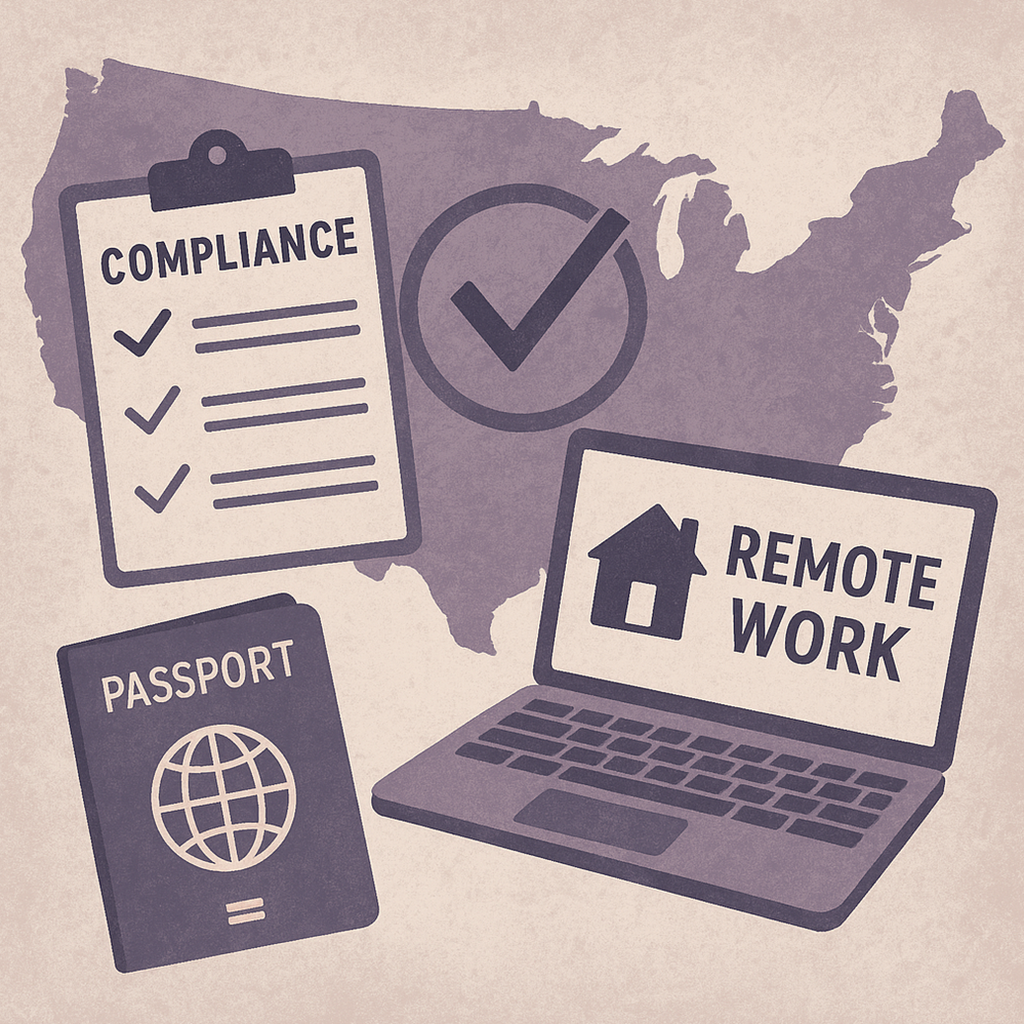Why location matters: Avoid US Immigration Compliance Risks for Remote Teams
Hybrid work gave employees freedom, but it also gave HR new liabilities. One employee working from another state or country without notice can trigger fines, visa violations, or I-9 audit risks overnight. For distributed teams, this is not a rare occurrence. It is part of daily operations.
Remote work is here to stay, but it comes with invisible immigration risks. Employees working from another state, city, or country can unintentionally trigger visa violations, I-9 errors, or non-compliance with local labor laws. For HR leaders managing global or hybrid teams, staying compliant requires more than traditional workflows. It demands proactive tracking of employee locations, visa statuses, and verification processes.
This guide breaks down the key risks and gives HR teams practical steps, checklists, and workflows to integrate immigration compliance into everyday operations.
US Employers with employees on US work visas
Why Location Matters: Avoid Remote Work Compliance Risks
Remote and distributed teams introduce new risks, especially in the United States, where work visas are location-specific. Even if an employee’s visa is approved, their actual work location determines the employer’s legal obligations.
H-1B Site-Specific Requirements
An H-1B (H-1B1 and E-3) visa is tied to a specific worksite listed on the Labor Condition Application (LCA). Any change in an employee’s work location, even temporary, may require filing an amended LCA and possibly a new USCIS petition. Missing this step can result in penalties and jeopardize future filings.
I-9 Verification for Remote Hires
All new hires must have their work authorization verified within three business days of starting employment. Remote employees still require a compliant verification process. DHS now allows limited remote verification through E-Verify, but only for enrolled employers who follow the required procedures and maintain documentation.
Operational steps for HR leaders
- Maintain a centralized employee location registry for all visa holders.
- Set up an automated alert system for work location changes that may require an amended LCA or new I-9 verification.
- Educate managers and employees on the importance of reporting location changes proactively.
By integrating location tracking, I-9 verification, and visa compliance into HR operations, teams can prevent fines, avoid filing delays, and keep employees productive.
Operational takeaway: To maintain US immigration compliance for remote teams, track every employee’s location, visa type, and work authorization status as part of your regular HR workflows.
US Employers with employees on Digital Nomad work visas
Global Digital Nomad Visas and HR Implications
Countries such as Portugal, Spain, and Estonia have introduced digital nomad visas that attract global talent. However, they do not remove employer compliance responsibilities.
HR considerations:
- Each country maintains its own registration, tax, and reporting rules.
- Employees may still fall under local labor or tax laws, even if employed by a foreign entity.
- The U.S. and U.K. continue to treat visa categories as location-specific, making internal tracking essential.
Operational takeaway: Treat every remote work location as a compliance checkpoint. Capture this data in HR systems and verify visa and tax obligations before approving remote arrangements.
Essential Immigration Compliance Checklist for HR Teams
Use this checklist to strengthen your immigration compliance program:
✅ Create a remote-work disclosure policy. Require employees to notify HR before changing their work location or traveling abroad.
✅ Integrate immigration checks into HR workflows. Make location confirmation a required step during onboarding, transfers, and hybrid arrangements.
✅ Maintain centralized documentation. Store all visa petitions, LCAs, and I-9 records in a single system for audit readiness.
✅ Train managers and employees. Educate stakeholders on reporting requirements and why location compliance matters.
✅ Conduct periodic audits. Review visa records and I-9s at least every six months
to ensure accuracy and compliance.
✅ Audit short-term remote assignments. Track temporary work-from-abroad situations that might trigger tax or immigration exposure.
FAQs: Remote Work and Immigration Compliance for Employers
1. Can H-1B employees work remotely from another state?
Yes, but HR must ensure the new location is covered by a valid Labor Condition Application (LCA). Moves outside the approved area may require an amended H-1B petition.
2. Do remote hires still need I-9 verification?
Yes. All U.S. employers must verify new hires’ work authorization within three business days. Remote verification is possible via E-Verify, but only for enrolled employers.
3. How can HR teams operationally manage immigration compliance?
Use centralized tracking, integrate location updates into workflows, train managers and employees, and consider platforms like Waylit to automate monitoring and reporting.
Have questions? Reach out to us at: support@waylit.com
How WayLit Helps
Managing immigration compliance across distributed teams does not have to be complicated. WayLit helps HR teams automate the critical parts of the process:
- Track visas, LCAs, and work authorizations in real time with automated alerts for renewals or location changes.
- Automate I-9 verifications and remote-work compliance workflows.
- Provide audit-ready reports that reduce operational stress during inspections.
- Partner with local experts for region-specific compliance support.
- Integrate with HR systems to simplify onboarding, document collection, and ongoing monitoring.
WayLit turns immigration compliance from a manual process into a predictable, scalable HR workflow.
Looking Ahead: Compliance Without Compromise
Remote work has redefined where employees work and how HR manages compliance. By embedding immigration compliance into HR systems, HR leaders can stay proactive instead of reactive.
With the right tools, visibility, and processes, compliance becomes a natural extension of workforce management, and not a last-minute scramble.


.svg)

